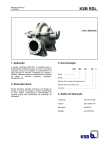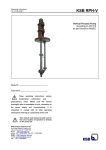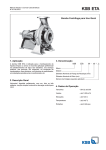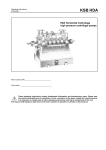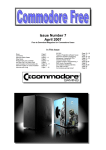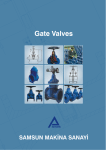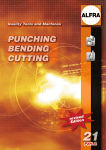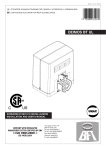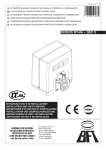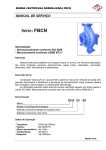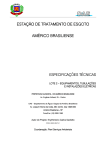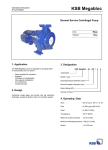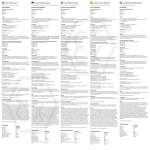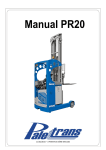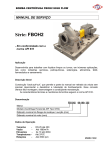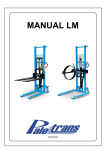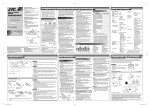Download RDL - KSB Brasil
Transcript
Operating Instructions Nº A1385.8E/3 KSB RDL Axially split volute casing pump acc. to Directive 98/37/EC Works Nº: _______________________________ Type Series: _________________________ These operating instructions contain fundamental information and precautionary notes. Please read the manual thoroughly prior to installation of unit, electrical connection and commissioning. It is imperative to comply with all other operating instructions referring to components of individual units. This manual shall always be kept close to the unit’s location of operation or directly on the pump set. RDL 0. Introduction KSB has supplied you an equipment that has been designed and manufactured with the latest technology. Due to its simple and tough construction, it will need little maintenance. With the aim to provide our clients with satisfactory, trouble free operation, we recommend to install and maintain our equipment according to the instructions contained in this service manual. This manual has been prepared to inform the end user about construction and operation of our pumps, describing the proper procedures for handling and maintenance. We recommend that this manual should be handed over to the maintenance supervision. The equipment must be used at operation conditions for which it has been selected, such as: flow rate, total head, speed, voltage, frequency and temperature of pumped liquid. Field for description of manufacturer data Field for Order number (serial number - OP) Description of type and size of the pump Fig.1 – Nameplate For requests about the equipment, or when ordering spare parts, please mention the type of pump and the Production Order number. This information can be obtained from the nameplate of each pump. If the nameplate is not available, the OP number is stamped in low relief on the suction flange and on the discharge flange you may find the impeller diameter. ATTENTION: This instruction manual contains very important recommendations and instructions. Must be carefully read before installation, electrical connection, first start up and maintenance. 2 RDL 1 General This KSB pump has been developed in accordance with state-of-the-art technology; it is manufactured with utmost care and subject o continuous quality control. These operating instructions are intended to facilitate familiarization with the pump and its designated use. The manual contains important information for reliable, proper and efficient operation. Compliance with the operating instructions is of vital importance to ensure reliability and a long service life of the pump and to avoid any risks. These operating instructions do not take into account local regulations; the operator must ensure that such regulations are strictly observed by all, including the personnel called in for installation. This pump / unit must not be operated beyond the limit values specified in the technical documentation for The medium handled, capacity, speed, density, pressure, temperature and motor rating. Make sure that operation is in accordance with the instructions laid down in this manual or in the contract documentation. (Contact the manufacturer, if required). The nameplate indicates the type series / size, main operating data and works number; please quote this information in al queries, repeat orders and particularly when ordering spare parts. If you need any additional information or instructions exceeding the scope of this manual or in case of damage, please contact KSB’s nearest customer service center. For noise characteristics please refer to section 4.4.7. 2 Safety These operating instructions contain fundamental information which must be complied with during installation, operation and maintenance. Therefore this operating manual must be read and understood both by the installing personnel and the responsible trained personnel / operators prior to installation and commissioning, and it must always be kept dose to the location of operation of the machine / unit for easy access. Not only must the general safety instructions laid down in this chapter on “Safety” be complied with, but also the safety instructions outlined under specific headings, particularly if the pump/unit is operated in hazardous areas (see section 2.9). 2.1 Marking of instructions in the manual The safety instructions contained in this manual whose non-observance might cause hazards to persons are specially marked with the symbol general hazard sign to ISO 7000-0434 The electrical danger warning sign is safety sign to IEC 417-5036 and special instructions concerning explosion protection are marked The word is used to introduce safety instructions whose non-observance may lead to damage to the machine and its functions. Instructions attached directly to the machine, e.g. - arrow indicating the direction of rotation - markings for fluid connections must always be complied with and be kept in perfectly legible condition at all times. 3 RDL 2.2 Personnel qualification and training All personnel involved in the operation, maintenance, inspection and installation of the machine must be fully qualified to carry out the work involved. Personnel responsibilities, competence and supervision must be clearly defined by the operator. If the personnel in question is not already in possession of the requisite know-how, appropriate training and instruction must be provided. If required, the operator may commission the manufacturer / supplier to take care of such training. ln addition, the operator is responsible for ensuring that the contents of the operating instructions are fully understood by the responsible personnel. 2.3 Non-compliance with safety instructions Non-compliance with safety instructions can jeopardize the safety of personnel, the environment and the machine itself. Noncompliance with these safety instructions will also lead to forfeiture of any and all rights to claims for damages. In particular, non-compliance can, for example, result in: failure of important machine / plant functions failure of prescribed maintenance and servicing practices hazard to persons by electrical, mechanical and chemical effects hazard to the environment due to leakage of hazardous substances. Ex symbol relates to additional requirements which must be adhered to when the pump is operated in hazardous areas. 2.4 Safety awareness It is imperative to comply with the safety instructions contained in this manual, the relevant national health and safety regulations and the operator’s own internal work, operation and safety regulations. 2.5 Safety instructions for the operator / user - Any hot or cold components that could pose a hazard must be equipped with a guard by the operator. - Guards which are fitted to prevent accidental contact with moving parts (e.g. coupling) must not be removed whilst the machine is operating. - Leakage (e.g. at the shaft seal) of hazardous media handled (e.g. explosive, toxic, hot) must be contained so as to avoid any danger to persons and the environment. Pertinent legal provisions must be adhered to. - Electrical hazards must be eliminated. (In this respect refer to the relevant safety regulations applicable to different countries and/or the local energy supply companies.) - Any components in contact with the pumped product, especially in the case of abrasive products, shall be inspected for wear at regular intervals and replaced by original spare parts (see section 2.7) in due time. If the pumps/units are located in hazardous areas, it is imperative to make sure that unauthorized modes of are pr operation are prevented. Non-compliance may result in the specified temperature limits being exceeded. 2.6 Safety instructions for maintenance, inspection and installation work The operator is responsible for ensuring that all maintenance, inspection and installation work be performed by authorized, qualified specialist personnel who are thoroughly familiar with the manual. The pump must have cooled down to ambient temperature. it must be drained and its pressure must be released. Work on the machine must be carried out only during standstill. The shutdown procedure described in the manual for taking the machine out of service must be adhered to without fail. Pumps or pump units handling media injurious to health must be decontaminated. Immediately following completion of the work, all safety-relevant and protective devices must be re-installed and/or reactivated. Please observe all instructions set out in the chapter on “Com missioning” before returning the machine to service. 2.7 Unauthorized modification and manufacture of spare parts Modifications or alterations of the machine are only permitted after consultation with the manufacturer. Original spare parts and accessories authorized by the manufacturer ensure safety. The use of other parts can invalidate any liability of the manufacturer for consequential damage. 2.8 Unauthorized modes of operation The warranty relating to the operational reliability and safety of the pump / unit supplied is only valid if the machine is used in accordance with its designated use as described in the following sections. The limits stated in the data sheet must not be exceeded under any circumstances. 4 RDL 2.9 Explosion protection If the pumps/units are installed in hazardous areas, the measures and instructions given in the following sections 2.9.1 t be ad to 2.9.6 must be adhered without fail, to ensure explosion protection. 2.9.1 Unit fill filled It is assumed that the system of suction and discharge lines and thus the wetted pump internal are completely filled with the product to be handled at all times during pump operation, so that an explosive atmosphere is prevented. If the operator cannot warrant this condition, appropriate monitoring devices must be used. N.B.: In addition, it is imperative to make sure that the seal chambers, auxiliary systems of the shaft seal and the heating and cooling systems are properly filled. 2.9.2 Marking The marking on the pump only refers to the pump part, i.e. the coupling and motor must be regarded separately. The coupling must have an EC manufacture’s declaration. The driver must be regarded separately. Example of marking on the pump part: Ex II 2 G T1 - T5. The marking indicates the theoretically available temperature range as stipulated by the respective temperature classes. The temperatures permitted for the individual pump variants are outlined in section 2.9.5. 2.9.3 Checking the direction of rotation (see also 6.1.4) If the explosion hazard also exists during the installation phase, the direction of rotation must never be checked by starting starting up the unfilled pump unit, even for a short period, to prevent temperature increases resulting from contact between rotating and stationary components. 2.9.4 Pump operating mode Make sure that the pump is always started up with the suction-side shut-off valve fully open and the discharge-side shut-off valve slightly open. However, the pump can also be starded up against a closed swing check valve. The discharge-side shut-off valve shall be adjusted to comply with the duty point immediately following the run-up process (see 6.1). Pump operation with the shut-off valves in the suction and/or discharge pipes closed is not permitted. In this condition, there is a risk of the pump casing taking on high surface temperatures after a very short time, due to a rapid temperature rise in the pumped product inside the pump. Additionally, the resulting rapid pressure build-up inside the pump may cause excessive stresses on the pump materials or even bursting. The minimum flows indicated in tables 4.3 and 4.3.1 refer to water and water-like liquids. Longer operating periods with these liquids and at the flow rates indicated will not cause an additional increase in the temperatures on the pump surface. However, if the physical properties of the fluids handled are different from water, it is essential to check if an additional heat build-up may occur and if the minimum flow rate must therefore be increased. To check, proceed as described in tables 4.3 and 4.3.1. In addition, the instructions given in section 6 of this operating manual must be observed. N.B.: Both gland packings and mechanical seals may exceed the specified temperature limits if run dry. Dry running may not only result from an inadequately filled seal chamber, but also from excessive gas content in the fluid handled. Pump operation outside its specified operating range may also result in dry running. In hazardous areas, gland packings shall only be used if combined with a suitable temperature monitoring device. 2.9.5 Temperature limits In normal pump operation, the highest temperatures are to be expected on the surface of the pump casing, at the shaft shaft seal and in the bearing areas. The surface temperature at the pump casing corresponds to the temperature of the fluid handled. If the pump is heated, it must be ensured that the temperature classes stipulated for the plant are observed. In the bearing bracket area, the unit surfaces must be freely exposed to the atmosphere. 5 RDL In any case, responsibility for compliance with the specified fluid temperature (operating temperature) lies with the plant operator. The maximum permissible fluid temperature depends on the temperature class to be complied with. Due to its design, temperature limit for pumps RDL could be acc. to temperature class T4 to EN 13463-1 and the resulting theoretical temperature limit of the fluid handled is 120 ºC. In stipulating this temperature, any temperature rise in the shaft seal area has already been taken into account. Note: operation with liquids above 105 ºC is permitted only after KSB approval. Safety note: The permissible operating temperatures of the pump in question is indicated on the data sheet. If the pump is to be operated at a higher temperature, the data sheet is missing or if the pump is part of a pool of pumps, the maximum permissible operating temperature must be inquired from the pump manufacturer. Based on an ambient temperature of 40ºC and proper maintenance and operation, compliance with temperature class T4 is warranted in the area of the rolling element bearings. A special design is required for compliance with temperature class T5 in the bearing area. In such cases, and if ambient temperature exceeds 40ºC, contact the manufacturer. 2.9.6 Maintenance Only a pump unit which is properly serviced and maintained in perfect technical condition will give safe and reliable operation. This also applies to the reliable function of the rolling element bearings whose actual lifetime largely depends on the operating mode and operating conditions. Regular checks of the lubricant and the running noises will prevent the risk of excessive temperatures as a result of bearings running hot or defective bearing seals (also see section 7.3). The correct function of the shaft seal must be checked regularly. Any auxiliary systems installed must be monitored, if necessary, to make sure they function correctly. Gland packings must be tightened correctly, to prevent excessive temperatures due to packing running hot. 3. Transport and interim storage 3.1 Transport Transportation of the motor-pump assembly or only pump, should be performed with skill and good sense by trained personnel observing safety regulations. Lift only motor with eyebolt, never use it to lift motor-pump assembly. In the pump upper casing there are 2 hooks, which should be used only for disassembly and transport of this part. Do not transport the pump or motorpump assembly with these hooks. The pump can be transported according to fig.2 by ropes or steel cables crossed in the neck of suction and discharge flanges. For transportation of set with common baseframe for pump and motor (according to figure 3), in case of baseframe deformation possibility, transport pump, motor and baseframe separately. If the pump/unit slips out of the suspension arrangement, it may cause personal injury and damage to property! 6 RDL Fig.2 – Transport of pump through seats of bearing casings Fig.3 – Transport of complete set with common baseframe for pump and motor (since there is no possibility of baseframe deformation due to its excessive length) Note: Take care to not lose or damage coupling guard or foundation bolts during transport. 3.2 Interim Storage (indoors) / Preservation KSB and its Dealer Network perform the following procedures of service and storage until effective delivery of the pump. It is client responsibility to continue with these procedures after receiving the pump. When a performance test after the pump sale is not applied, the machined areas in contact with the pumped liquid which are not painted, receive an application of RUSTILO DW-301 by brush. When the pump is equipped with gland packing subject to a performance test, it is drained after test without disassembling it, and then filled up with RUSTILO DW-301 rotating its rotor assembly to improve the RUSTILO application. After that the pump is drained again. On the shaft exposed areas, a brush application of TECTYL 506 is made. On oil lubricated pump bearing brackets, bearings receive a layer of MOBILARMA 524 by spray. 3.2.1 Additional procedure for storage • Pumps stored for periods exceeding one year should be re-protected every 12 months. They must be disassembled, cleaned and the whole process described above should be repeated. • Grease lubricated bearings are charged with grease and do not need maintenance. • Gland packing equipped pumps should have their packing removed before storage. • Mechanical seals should be cleaned with dry compressed air. No other liquid or material must be applied to them, in order to prevent damage to the secondary sealing parts, such as o-rings and gaskets. • All connections, such as inlets for liquids from external sources, priming, draining, flushing / quench and cooling should be closed. Suction and discharge flanges should be covered to prevent the entry of foreign bodies. • Stored pumps should be turned by hand every 15 days. If it is difficult to move them by hand, use a pipe adjustable spanner wrench, protecting the shaft surface at the place of application. • Wash exposed surfaces with gasoline or kerosene before applying the protecting liquids. • Characteristics of the used protecting liquids: 7 RDL Protecting Liquid Thickness of applied layer µm (in) Drying Time Removal Manufacturer TECTYL 506 80 to100 (.003 to .004) ½ up to 1 hour Gasoline/Benzene/Diesel Oil BRASCOLA RUSTILO DW301 6 to 10 (.0002 to .0004) 1 up to 2 hours Gasoline/Benzene CASTROL MOBILARMA 524 ≤ 6 (.0002) Does not dry Not necessary MOBIL OIL Table 2 – Protecting liquids 4. Description of the product Horizontal single stage, axially split volute casing pump with double entry radial impeller. Drive shaft end of the pump can be fitted either on the left or right end side. Flanges according to DIN or ANSI. 4.1 Technical specification It is recommended for pumping clean or cloudy liquids in the following application: water supply drainage irrigation chemical and petrochemical industry air conditioning paper and cellulose industry fire-fighting 4.2 Designation KSB RDL 250 - 500 A Trade Mark Model Discharge nozzle diameter (mm) Impeller nominal diameter (mm) Impeller type 8 4.3. Technical data (Metric units) 800-970 800-840 800-740 700-820 700-710 700-590 600-830 600-710 600-620 600-540 500-890 500-790 500-700 500-640 500-510 400-850 400-620 400-540 400-480 400-440 400-390 350-620 350-500 300-620 300-500 300-400 300-340 300-280 250-620 250-500 250-400 250-340 250-280 200-620 200-500 200-400 200-340 200-280 150-500 150-430 150-400 150-340 150-310 150-280 150-250 125-310 125-250 125-200 125-170 Unities 125-140 Pump size Constructive data Maximum A48CL30 discharge pressure A536-60-40-18 Maximum A48CL30 pressure hydrostatic A536test 60-40-18 10 10 16 25 25 16 10 25 10 10 16 16 10 10 16 16 25 10 10 10 16 25 10 10 16 16 25 16 25 10 10 16 16 25 25 10 10 16 25 25 10 10 16 16 10 10 16 10 10 10 25 25 25 40 40 40 16 40 16 25 25 40 16 16 25 25 40 16 16 25 25 40 16 25 25 25 40 25 40 16 16 25 25 40 40 16 25 25 25 25 16 16 25 25 16 16 16 16 16 16 bar bar Double volute pump X X X X X Maximum rotation cd A Width in the impeller end (b2) see fig. 4 A Maximum diameter for solid crossing A 25 28 11 13,5 18 18 10 12 18 10 11 13 35 36 20 22 27 27 18 20 24 16 17 X X X X X 20 X X X X X X Q > 0,25 Qot. ºC 105º g rpm 3650 1800 3650 d 1800 d 1800 40,8 40,8 --- d 1800 d 1800 --- --- h 1450 1800 1800 B --- 1200 1200 1200 900 1800 28 24 44 50,6 26 38,4 40 22 33 66 50,4 38 39 30 76 65,5 60 54,8 43 102 80 64 62 53 70 84 112 93 86 89,4 80 45 136 100 116 100 --- 153 146 130 115 231 165 134 210 206 174 24 22 16 --- 40 31 36,8 32 19 30 52 56,6 26 26 30 85,4 56 50 42 32 86 84 62 58,8 47 --- --- 106 94 100 85 81 --- 129 108 100 104 88 143 138 120 103 148 157 128 190 193 160 22 --- 16 17 23 28 17 29 26 22 21 36 33 26 25 23 43 39 38 39 34 55 48 43 42 43 48 55 56 61 51 56 58 48 75 50 75 68 --- 86 73 75 72 114 82 --- --- --- 87 --- 16 13 17 --- 30 22 25 26 18 17 30 30 24 24 20 48 33 32 33 30 46 42 31 40 40 --- --- 76 47 58 50 56 --- 57 54 50 71 63 47 77 60 65 79 78 -- 95 114 81 mm B 33 --- 23 18 mm B Wear ring change without machining simple - change mm 0,70 0,75 0,85 0,75 0,85 0,80 0,85 0,95 1,0 Rotation direction 1,1 1,2 Wear ring change with re-machining 1,2 --- 1,2 1,3 1,2 1,4 1,4 --- 1,4 1,4 1,4 1,5 1,5 1,5 1,5 1,6 1,7 1,7 1,2 1,2 --- 1,2 1,2 --- 1,4 1,5 1,3 1,3 1,4 1,3 1,4 1,5 1,5 1,6 1,6 1,6 1,1 Clockwise or counter clockwise according to position of drive (see fig. 14 and 15) DIN DIN EN 1092 – 2 types 21 Form B - PN16 or DIN EN1092 – 2 types 21 Form B – PN25 ANSI Fx, Fy, Fz B 16.1 125 lb FF or 250 lb RF N 1470 Mx, My, Mz Nm 980 Free side Bearings (Clearance C3) Drive side Lubrication 18 28 Q > 0,40 Qot. d Interchangeability between impellers A and B Sealing clearance A in the diameter (d2 – d1) B see fig.4 Flanges (function of end pressure) Permissible forces and moments in the flanges (see fig.5) f 18 25 Q > 0,25 Qot. H≤50m With single Minimum volute H>50m flow With double volute Maximum temperature 11 18 According to Hydraulic Institute 2450 1470 2940 3920 1960 4900 2695 2940 6307 6308 6307 6310 6312 6314 6316 6307 9308 6307 6310 6312 6314 6316 6314 6316 5880 7840 3430 3920 4900 9800 10780 7840 11760 8820 6318 6320 6324 6316 6320 6322 6324 6328 6316 6318 6322 6324 6320 6322 6326 6322 6324 6328 NU type 320 314 600 90 316 318 320 324 316 320 322 324 328 316 318 322 324 320 322 326 322 324 328 110 380 535 780 110 635 670 780 940 110 380 670 780 535 670 870 670 780 940 0,78 1,12 1,59 2,83 0,78 1,59 2,16 2,83 4,62 0,78 1,12 2,16 2,83 1,59 2,16 2,36 2,16 2,83 4,63 grease e Capacity for bearing g 27 36 27 54 72 90 110 Max. admissible P/n i CV rpm 0,074 0,113 0,074 0,228 0,386 0,63 0,93 GD2 with water kgm 0,07 0,12 0,17 0,30 0,53 0,41 0,56 0,75 0,97 1,49 1,89 2,94 0,88 1,57 2,55 5,03 9,53 2 ØD 80 Ød Shaft seal housing 6320 5390 85 80 95 1,2 2,22 3,64 7,37 14,27 1,68 112 122 3,0 0,53 0,83 0,50 4,97 10,22 19,97 14,0 24,0 6,25 9,42 12,3 17,9 27,9 150 170 122 150 160 170 105 19,5 41,4 55,8 83,3 125 29,1 46,4 72,8 121 51,5 94,0 200 150 230 150 200 170 170 180 200 160 180 200 141 127 210 185 289 230 55 60 55 70 80 90 110 130 90 110 120 130 150 110 130 140 150 180 110 120 140 150 130 150 160 180 95 95 95 95 125 125 150 150 125 150 150 150 180 150 150 150 180 180 150 150 150 180 150 180 180 180 mm L 12 x 12 kg 155 156 158 160 165 241 242 263 265 276 337 360 338 16 x 16 356 373 524 797 465 504 520 Table 1 9 c See item 6.2.1, peripherical speed d Pumps 200-620A, 250-620A, 300-500A, 300-620A and 350-620A can operate in 1750rpm, with reinforced bearings, subject to release by the KSB Product Department e For lubrication with oil, please consult KSB Product Department 725 20 x 20 985 695 785 16x16 20 x 20 25x25 20 x 20 25x25 20 x 20 25x25 20x20 25 x 25 926 1165 1515 1506 2120 1077 1375 1460 1777 2135 4500 1528 2301 2967 3483 4659 2725 2961 3427 4700 4043 5329 6075 6557 6624 7809 f Values valid for materials A48CL30 and NI-Resist For material: A536 60-40-18 multiply the values by 1.4 Casted carbon steel multiply values by 1.7 Casted chrome steel, please consult KSB g For higher temperatures, consult KSB h Maximum rotation = 880rpm for hydraulic A i For material SAE 1045 RDL Net weight 4.3.1 Technical data (English units) 250-400 250-500 250-620 300-280 300-340 300-400 300-500 300-620 350-500 400-390 400-440 400-480 400-540 400-620 400-850 500-510 500-640 500-700 500-890 600-540 600-620 600-710 600-830 700-590 700-710 700-820 800-740 800-970 250-280 800-840 200-620 500-790 200-500 350-620 200-400 250-340 200-340 200-280 150-500 150-430 150-400 150-340 150-310 150-280 150-250 125-310 125-250 125-200 125-170 Units 125-140 Pump size 145 145 232 362 362 232 145 362 145 145 232 232 145 145 232 232 362 145 145 145 232 362 145 145 232 232 362 232 362 145 145 232 232 362 362 145 145 232 362 362 145 145 232 232 145 145 232 145 145 145 362 362 362 580 580 580 232 580 232 362 362 580 232 232 362 362 580 232 232 362 362 580 232 362 362 362 580 362 580 232 232 362 362 580 580 232 362 362 362 362 232 232 362 362 232 232 232 232 232 232 160 260 260 362 28 160 13,5 260 260 145 174 260 145 160 188 260 362 406 507 522 290 390 260 290 348 232 246 290 Constructive data Maximum A48CL30 discharge pressure A536-60-40-18 Maximum pressure A48CL30 hydrostatic A536test 60-40-18 psi psi According to Hydraulic Institute Double volute pump X X X X X Maximum rotation •‚ A Width in the impeller end (b2) see fig. 4 A Maximum diameter for solid crossing A X ‚ 1800 ‚ 1800 --- --- X X X X X X X X Q > 0,40 Qot. Q > 0,25 Qot. 221º … ºF ‚ rpm 3650 18003650 ‚ 1800 ‚ 1800 † 1450 1800 1800 B --- 1200 1200 1200 900 1800 1.611.61 --- 1.10 .945 1.731.99 1.02 1.51 1.57 .866 1.30 2.60 1.98 1.50 1.54 1.18 2.99 2.58 2.36 2.16 1.69 4.02 3.15 2.52 2.44 2.09 2.76 3.31 4.41 3.66 3.39 3.52 3.15 1.77 5.35 3.94 4.57 3.94 --- 6.02 5.75 5.12 4.53 9.09 6.50 5.28 8.27 8.11 6.85 in B 1.30 --- .945 .866 .630 --- 1.57 1.22 1.45 1.26 .748 1.18 2.04 2.23 1.02 1.02 1.18 3.36 2.20 1.97 1.65 1.26 3.39 3.31 2.44 2.31 1.85 --- --- 4.17 3.70 3.94 3.35 3.19 --- 5.08 4.25 3.94 4.09 3.46 5.63 5.43 4.72 4.06 5.83 6.18 5.04 7.48 7.60 6.30 .906.866 --- .630 .669 .9061.10 .669 1.14 1.02 .866 .827 1.42 1.30 1.02 .984 .906 1.69 1.54 1.50 1.54 1.34 2.17 1.89 1.69 1.65 1.69 1.89 2.17 2.20 2.40 2.01 2.20 2.28 1.89 2.95 1.97 2.95 2.68 --- 3.39 2.87 2.95 2.83 4.49 3.23 --- 2.24 2.13 1.97 2.80 2.48 1.85 3.03 2.36 2.56 3.11 3.07 -- --- --- 3.43 in B .709 --- .630 .512 .669 --- 1.18 .866 .984 1.02 .709 .669 1.18 1.18 .945 .945 .787 1.89 1.30 1.26 1.30 1.18 1.81 1.65 1.22 1.57 1.57 Interchangeability between impellers A and B Sealing clearance A in the diameter (d2 – d1) B see fig.4 --- 2.99 1.85 2.28 1.97 2.20 .028 .030.033 .030 .033 .031 .033 --- Wear ring change without machining .047 in .037 .039 .043 .047 --- 3.74 4.49 3.19 Wear ring change with re-machining .047 .051 .047 .055 .055 --- .055 .055 .055 .059 .059 .059 .059 .063 .067 .067 .043 .047 .047 --- .047 .047 --- .055 .059 .051 .051 .055 .051 .055 .059 .059 .063 .063 .063 Clockwise or counter clockwise according to position of drive (see fig. 14 and 15) Flanges DIN (function of end ANSI pressure) Permissible Fx, Fy, Fz lbf forces and moments in the flanges Mx, My, Mz ft-lb (see fig.5) „ Free side Bearings (Clearance C3) Drive side DIN EN 1092 – 2 types 21 Form B - PN16 or DIN EN1092 – 2 types 21 Form B – PN25 B 16.1 125 lb FF or 250 lb RF 330 720 550 1080 660 880 1440 1100 1980 2160 6307 6308 6307 6310 6312 6314 6316 6307 6308 6307 6310 6312 6314 6316 1210 1320 1760 2530 2890 3610 2200 2420 5780 2640 6500 6320 6314 6316 6318 6320 6324 6316 6320 6322 6324 6328 6316 6318 6322 6324 6320 6322 6326 6322 6324 6328 320 314 316 318 21.2 3.17 3.88 13.4 18.9 27.5 3.88 23.4 23.6 27.5 33.2 3.88 13.4 23.6 27.5 18.9 23.6 30.7 23.6 27.5 33.2 .523 .818 .493 .769 1.10 1.57 2.79 .769 1.57 2.13 2.79 4.55 .769 1.10 2.13 2.79 1.57 2.13 2.33 2.13 2.79 4.56 NU 320 324 316 320 322 324 328 316 318 322 324 320 322 326 322 324 328 grease ƒ type Capacity for oz bearing Maximum admissible P/n (7) hp rpm .95 1.27 .95 1.90 2.54 3.17 3.88 .073 .111 .073 .225 .381 .621 .917 lbft2 1.662.85 4.03 7.12 12.6 9.7313.3 17.8 23.0 35.4 44.9 69.8 20.9 37.3 60.5 119 GD2 with water Shaft seal housing --- simple - change Rotation direction Lubrication X 390 Q > 0,25 Qot. H≤164ft With single Minimum volute H>164ft flow With double volute Maximum temperature X 319 226 28.5 52.7 86.4 175 339 39.9 71.2 118 243 474 332 570 148 224 292 425 662 2490 463 982 1320 1980 2970 690 1100 1730 2870 1220 2230 3350 3010 4390 6860 ØD 3.15 3.35 3.15 3.74 4.41 4.80 5.91 6.69 4.80 5.91 6.30 6.69 7.87 5.91 6.69 7.09 7.87 9.06 5.91 6.30 7.09 7.87 6.69 7.87 8.27 9.06 Ød 2.17 2.36 2.17 2.76 3.15 3.54 4.33 5.12 3.54 4.33 4.72 5.12 5.91 4.33 5.12 5.51 5.91 7.09 4.33 4.72 5.51 5.91 5.12 5.91 6.30 7.09 3.74 3.74 3.74 3.74 4.92 4.92 5.91 5.91 4.92 5.91 5.91 5.91 7.09 5.91 5.91 5.91 7.09 7.09 5.91 5.91 5.91 7.09 5.91 7.09 7.09 7.09 in L .47 x .47 lb 342 344 348 353 364 531 534 580 584 608 743 794 745 785 .79 x .79 .63x.63 .79 x .79 .98x.98 .79 x .79 .98x.98 .79 x .79 .98x.98 .79x.79 .98 x .98 822 1155 1760 1025 1110 1145 1600 2170 1530 1730 2040 2570 3340 3320 4670 2370 3030 3220 3920 4700 9920 3370 5070 6540 7680 10270 6010 6530 7555 10360 8910 11750 13390 14460 14600 17220 Table 1 „ Values valid for materials A48CL30 and NI-Resist 10 • See item 6.2.1, peripherical speed ‚ Pumps 200-620A, 250-620A, 300-500A, 300-620A and 350-620A can operate in 1750rpm, with reinforced bearings, subject to release by the KSB Product Department ƒ For lubrication with oil, please consult KSB Product Department For material: A536 60-40-18 multiply the values by 1.4 Casted carbon steel multiply values by 1.7 Casted chrome steel, please consult KSB … For higher temperatures, consult KSB † Maximum rotation = 880rpm for hydraulic A Æ For material SAE 1045 RDL Net weight .63 x .63 RDL Fig.4 – Sealing clearance and impeller diameter Fig.5 – Permissible forces and moments on the flanges (see table 1) 4.4 Design details 4.4.1 Casing Horizontal, axially split volute casing, with upper and lower casing. Horizontal and opposite suction and discharge nozzle, in the lower casing. The surfaces between the casings are properly machined and the sealing is done with seal bandage of silicone (598 HB Loctite). This design allows disassembly of the impeller, shaft and sleeves without disassembly of the piping. The protection of pump casing against wear caused by impeller rotation is made through replaceable wear rings fixed in machined channels in the lower casing. This system prevents rotation and axial displacement of wear rings. 4.4.2 Impeller Impeller is radial, double suction, with vanes of wide curvature, fixed on the shaft by means of two symmetric parts set (space sleeve, shaft protecting sleeve and shaft nut). Shaft nuts are out of flow area and are locked to the shaft by means of threaded screw and pins. From size 600-540 inclusive the impeller is produced with replaceable wear rings. In special execution up to size 500-890 inclusive impeller wear rings can also be provided. Usually two different standard and interchangeable hydraulics (A and B), are available for each pump size. Axial thrust is hydraulically compensated. 4.4.2.1 Peripheral Speed When determining pump rotation, always check if impeller material is appropriate for the peripheral speed. (Fig.6). 4.4.3 Shaft Pump shaft is supported between bearings. Bearing casings are fixed to their brackets to facilitate the disassembly of rotor together with the bearing. Up to size 500-890 the bearing casing is part integrated to the lower casing. For bigger sizes bearing brackets are fixed to the lower casing through studs and nuts. Bearings are protected by sealing rings on shaft against drop from the stuffing box. Pumps up to DN 300 have ball bearings in both sides. For bigger sizes, bearings have cylindrical roller bearing at the drive end, and a deep groove ball bearing at the N.D.E. 4.4.4 Shaft Sealing Pump is shaft sealed by gland packing (standard) or optionally by mechanical seal. In the sealing area, the shaft is provided with easily replaceable protective sleeves. Usually gland packing is lubricated by pumped liquid, except on applications which the fluid is inadequate for these functions. In these cases, use an external source with clean liquid, with a pressure of 1,5 to 3,0 bar (20 to 40 psi) over the suction pressure. The volume of lubrication / sealing liquid of external source is obtained through the diagram according to fig. 7, and for wash use the same pressure and flow 10 times higher than that used for lubricating / sealing. Pressure and flow refer to values for each chamber. 11 RDL 1000 5 2 1 3 4 900 4 Peripheral speed limit for impeller in: A536 60-40-18 CuSn10-C-GS A743 CA6NM A743 CF8M 700 600 P (bar) Impeller diameter (mm) 800 3 2 500 400 1 300 200 500 0 1000 1500 2000 2500 3000 3500 4000 0 50 Peripheral speed=40m/s curve 1 1 1 1 1 1 1 1 1 1 150 200 250 300 350 Peripheral speed=60m/s Fig.6 – Peripheral Speed size 125-140 125-170 125-200 125-250 125-310 150-250 150-280 150-310 150-340 150-400 100 Q (l/h) rpm size 150-430 150-500 200-280 200-340 200-400 200-500 200-620 250-280 250-340 250-400 Fig.7 – Liquid flow of external source curve 1 2 2 2 2 2 2 2 2 2 ∆p = P – ps size 250-500 250-620 300-280 300-340 300-400 300-500 300-620 350-500 350-620 400-390 curve 3 3 3 3 3 3 3 3 3 3 size 400-440 400-480 400-540 400-620 500-510 500-640 500-700 500-790 500-890 600-540 curve 3 3 4 4 2 3 3 3 4 2 size 600-620 600-710 600-830 700-590 700-710 700-820 800-740 800-840 800-970 curve 2 3 3 3 3 3 2 2 3 where: P = pressure of external source liquid (bar) ps = suction pressure (bar) 4.4.5 Packing rings Usually shaft sealing is done with packing rings. Position of neck ring, packing rings and lantern ring are shown on fig. 8. Dimensions of seal chamber, packing rings are mentioned on table 1. The lantern ring, disposed between packing rings receives the liquid from the region of pump high pressure. Lantern ring makes the distribution of liquid which lubricates the packing and avoid the entrance of air in the pump. Liquid flow to the lantern ring is controlled by a valve installed in the pump external piping. Code 0 1 Description Sealing by liquid being pumped 0-1 with external piping 0-2 with external piping + filter • 1-1 Sealing through clean liquid of external source 9 Sealing with mechanical seal (2 seals) Fig.8 – Shaft sealing • When pumped liquid contains solid in suspension. 12 RDL 4.4.6 Mechanical seal Please refer to the mechanical seal drawing for details of the mechanical seal installed in the pump. Other seal configurations and types may only be used in exceptional cases and after consultation with KSB. The relevant seal version is shown in the mechanical seal drawing. After a short period of accommodation during operation, there is no more leakage. Mechanical seal is composed fundamentally of one stationary face and one rotating face, which polished surfaces are kept together by spring pressure. Sealing materials should be compatible with pumped liquid. Condition for safety and long operation, is based on a film of the liquid between the sealing faces and the generated heat being appropriately absorbed by liquid circulation. Depending on the pumping condition, this circulation can be of pumped liquid or liquid of external source. Mechanical seals are constructed in many different materials and assembly arrangement, covering almost all of chemical and physical characteristics of liquid to be pumped. When requested, shaft sealing by mechanical seal additional information will follow separately. 4.4.7 Noise characteristics Rated Power input PN (kW) 11,0 15,0 18,5 22,0 30,0 37,0 45,0 55,0 75,0 90,0 110 132 160 200 250 400 500 750 1000 1500 2000 Sound pressure level L pA (dB) Pump only 1) 2) Pump with motor 2900 1450 960/760 2900 1450 960/760 1/min 1/min 1/min 1/min 1/min 1/min 69 70,5 71,0 71,5 72,5 73,5 74 74,5 76 76,5 77 77,5 78 79 - 67,5 68,5 69 69,5 70,5 71,5 72 72,5 74 74,5 75 75,5 76 77 77,5 79 80 81 82 - 70,5 71,5 72 72,5 73 73,5 74,5 75 76,5 77,5 78,5 79,5 81 83 74,5 75,5 76 76,5 77,5 78 78,5 79 80 80,5 81,5 82 82,5 83 - 69,5 70,5 71,5 72 73 73,5 74,5 75 76 77 77,5 78 79 79,5 80 82 - 71 72,5 73,5 74 75 75,5 76,5 77,5 - 1) Measured at a distance of 1m from the pump outline (as per DIN 45635 Part 1 and 24). Room and foundation influences have not been included. The tolerance for these factors is 1 to 2 dB. 2) Increase for 60Hz operation Pump without motor: --Pump with motor: 3500min -1: +3dB, 1750min -1: +1dB, 1160min-1: ---dB 13 RDL 4.5 Accessories 4.5.1 Coupling RDL pumps can be equipped with standard coupling type KSB, or from other manufacturers. KSB standard couplings do not require maintenance, only periodical inspection (every 30 days) of elastic component condition and replacement, if necessary. Elastic component cannot be exposed to oil or grease contact. For maintenance of other coupling type, see manufacturer instruction. 4.5.2 Baseplate KSB standard is a structural welded baseplate. Common baseplate for pump and driver for sizes up to 500-890 and separated one for the pump, for bigger sizes. Fig.9 – Common baseplate for pump and motor Fig.10 – Baseplate only for pump 4.5.3 Coupling guard For a safety operation a coupling guard should be installed. Made according to KSB standards, of steel or brass. Installed on the transversal beam in case of common baseplate (see fig. 9) or on the foundation floor (see fig. 10). Coupling guard does not touch the rotating elements. 5. Installation at site Our pumps should be installed, leveled and aligned by trained personnel. If this work is done incorrectly it may cause operational problems, premature wear and damage beyond repair. 5.1 Safety regulations Equipment operated in hazardous locations must comply with the relevant explosion protection regulations. This is indicated on the pump name plate and motor name plate (see 2.9). 5.2 Checks to be carried out prior to installation All structural work required must have been prepared in accordance with the dimensions stated in the dimension table / G.A. drawing. The concrete foundations shall have sufficient strength (min. BN 150) to ensure safe and functional installation in accordance with DIN 1045 or equivalent standards. Make sure that the concrete foundation has set firmly before placing the unit on it. Its surface shall be truly horizontal and even. The foundation bolts shall be inserted in the baseplate holes . 14 RDL 5.3 Installing the pump/unit After placing the baseplate (preferably without the pump and driver) on the foundation, level it with the help of a spirit level placed on the pump and driver pads. Permissible deviation: 0.2 mm/m. Shims should be fitted between the baseplate and the foundation itself; they shall always be inserted to the left and right of the foundation bolts and in close proximity to these bolts. For a bolt-to-bolt clearance of more than 800 mm, additional shims shall be inserted halfway between the adjoining holes. All shims must lie perfectly flush. Insert the foundation bolts and set them into the foundation using concrete. When the mortar has set, level the baseplate as described in section 5.3.1 and tighten the foundation bolts evenly and firmly. Then grout the baseplate (see also 5.3.2) using low shrinkage concrete with a standard particle size and a water/concrete ratio of 0.5. The flowability must be produced with the help of a solvent. Secondary treatment of the concrete to DIN 1045 is an absolute necessity. Fig. 11: Fitting required shims To ensure low-noise operation, the unit can be mounted on vibration dampers (please confirm with KSB first). Expansion joints can be fitted between pump and suction/discharge line. 5.3.1 Base Leveling Check if the baseframe is equally leveled on its metallic shims. Place and tighten uniformly the nuts on the foundation bolts. Using a spirit level, check the leveling of the baseframe longitudinally and transversally. If the baseframe is unleveled, loosen the anchor bolts nuts and insert additional shims as necessary between the metallic chocks and the baseframe, so as to correct the leveling. See Fig. 12. Maximum leveling deviation: 0,2 mm/m. Fig.12 – Base Leveling 5.3.2 Grouting In order to obtain a rigidity structure and vibration free operation, the inner side of the baseframe should be filled with grout. This grout should be prepared with specific products available in the civil construction market, non-shrinking type in order to avoid contraction during the hardening process and also provide sufficient fluidity to fill the baseframe and prevent from cavities formation. See Fig.13 15 RDL Fig.13 – Grouting 5.4 Rotation direction KSB RDL Pumps can be coupled to the drive on both shaft ends. The rotation can be clockwise or counter-clockwise, a function of drive position and suction and discharge nozzles. To determine the rotation direction, be in front of the shaft drive side and look at the pump, follow the pumped liquid flow, which enters through the suction flange (bigger diameter), makes a complete turn inside the pump and goes out through the discharge flange (smaller diameter). See figures 14 and 15. If the shaft is assembled in one determined position, it can be reversed without special adaptation. Fig.14 – Counter Clockwise rotation Fig.15 – Clockwise rotation 5.5 Coupling Alignment The useful life of the rotor assembly and its operation free of irregular vibrations will rely on the perfect alignment between the pump and the driver. The alignment performed at the factory must be re checked due to the fact that during transportation and handling, the motorpump assembly is exposed to deformations, which may affect the initial alignment. The following instructions also apply to units not mounted on a common baseplate. After connecting the piping and priming the system, it is essential to re-check the alignment at operating temperature. Incorrect alignment and inadmissible coupling displacement will affect the operating behavior and may result in damage to the bearings and shaft seals as well as premature coupling wear. After the grouting has set hard, perform the alignment, if possible, with the suction and discharge pipe lines already connected. 16 RDL This alignment should be performed with the help of a dial indicator for the control of the radial and axial displacements. Fix the bottom of the instrument to the periphery of one of the coupling halves, adjust the position of the dial indicator perpendicular to the periphery of the another half of the coupling. Move the dial to zero and move by hand the coupling half in which the instrument bottom is fixed, making the dial indicator to complete a 360o. turn. See Fig. 16. The same procedure should be performed to control the axial displacement. See Fig. 17. Fig.16 – Radial control Fig.17 – Axial Control To correct the alignment, loosen the driver bolts, sliding it laterally or inserting shims to correct its height as necessary. Axial and radial alignments should be within the tolerance of 0,1 mm (0.004”) with the driver and pump fixing bolts tightened. If there is no dial indicator available, use a straight edge across the two parts of coupling sleeve. The control should be done on the horizontal and vertical planes. To control axially use a feeler gauge. See Fig. 18. Observe the coupling sleeve hub clearance specified by the manufacturer. Fig.18 – Alignment with straight edge and feeler gauge 5.6 Connecting the piping Never use the pump itself as an anchorage point for the piping. The permissible pipeline forces must not be ceeded (see exceeded (see table 1). Suction lift lines shall be laid with a rising slope towards the pump and suction head lines with a downward slope towards the pump. The pipelines shall be anchored in dose proximity to the pump and connected without transmitting any stresses or strains. The nominal diameters of the pipelines shall be at least equal to the nominal diameters of the pump nozzles. Connection flanges must be parallel to the pump flanges it is recommended to install check and shut-off elements in the system, depending on the type of plant and pump. It must be ensured, however, that the pump can still be drained and dismantled without problems. Thermal expansions of the pipelines must be compensated by appropriate measures so as not to impose any extra loads on the pump exceeding the permissible pipeline forces and moments. An excessive, impermissible increase in the pipeline forces may cause leaks on the pump where the medium handled can escape into the atmosphere. This may lead to danger to human life when toxic or hot media are handled! The flange covers on the pump suction and discharge nozzles must be removed prior to installation in the piping. 17 RDL Please check if a strainer/filter should be fitted in the suction line during the commissioning stage, in order to protect both the pump and the shaft seal from dam age due to contamination from the plant. In order to avoid any marked deterioration of the NPSH available, which would have an adverse effect on the pump, the strainer has to be cleaned whenever required. It is recommended to use a differential pressure gauge to detect any strainer clogging (see 6.1.6). For installation on a foundation with vibration insulation please take into account the when connecting the piping that the flexible elements at the baseplate may only compensate compressive and shearing strains within the admissible limits. Tensile strains cannot be compensated for, therefore the flexible elements shall only be firmly fastened to the foundation after connecting the piping. 5.6.1 Recommendation for suction piping Assembly of suction piping should comply with the following consideration: a) only after completing the grout set, piping can be connected to the pump flange; b) suction piping, as much as possible, should be short and straight, avoiding losses, and totally drained preventing air from entering; c) to be free of air pockets, in case of horizontal and negative suction, the piping should be installed with a slope in direction to the suction; d) nominal diameter of pump suction flange does not determine the nominal diameter of suction piping. For calculation of ideal diameter, as referential, use the flow speed established between 1 and 2,5 m/s (3 and 8 ft/s); e) when reducer is necessary, this should be eccentric and with the flat side located on the top as fig. 18. in order to avoid formation of air pockets; f) elbows, when necessary, should be designed and installed providing lower losses. Ex.: prefer elbow of long or medium radius; g) piping flange should adjust to the pump suction nozzle, totally free of tensions, without transmitting any stress to the pump casing. Pump should never be support for the piping. If it is not observed misalignment can occur and its consequences like parts scratch and other serious damages; h) in installation where foot valve is applicable observe that the passage area should be 1.5 time bigger than the piping area. Usually coupled to the foot valve should exist a strainer with a free passage of 3 to 4 times bigger than the piping area; i) when the pumped liquid is subject to high temperature variation expansion joints should be installed to avoid piping stresses caused by dilation and contraction of the pump; j) in positive suction it is recommended to install a valve in order to close the flow as necessary. During pump operation it must be totally opened. Suction with only one suction header for several pumps must have one valve for each pump and the connection between the suction header and the suction piping should always be with changes of direction lower than 45º. In all these cases with use of gate valve, the shaft of it should be disposed horizontally or vertically down; k) In order to avoid turbulence, air entering, sand or mud in the pump suction use HI the recommendations; l) Check coupling alignment after tightening piping; m) To facilitate piping assembly and parts adjustment, install, when necessary, Dresser type assembly joint, common or special type with tie bolts. Fig. 17 – Negative suction Fig. 18 – Positive suction 18 RDL 5.6.2 Recommendation for discharge piping Mounting of discharge piping should consider following items: a) Should have devices for control of water hammer when the pressure values from liquid return in long pipes exceed the recommended limits for piping and pump; b) Junction between discharge piping and pump flange should be made with a concentric reducer, when nominal diameters are different; c) Install vent valves to remove the air; d) Install a discharge valve, just after pump discharge nozzle , in order to adjust of flow and pumping pressure, or prevent driver overload; e) Check valve, when installed should be placed between the pump and the discharge valve. This location is preferable in relation to item d; f) Expansion joints with tie bolts should be considered to absorb system stresses; g) Safety valves or relief devices and other operation valves should be installed when necessary; h) Same recommendations a, b, f, g i, l, m, regarding suction piping. 5.6.3 Auxiliary connections The dimensions and locations of the auxiliary connections (sealing liquid, flushing liquid etc.) are indicated on the G.A. drawing and below. These connections are required for proper functioning of the pump and are therefore of vital importance! Modifications are only permitted after consulting KSB (see 2.7)! Description of piping and auxiliary connection 1M Manometer R ½” From RDL 200-280 up to 400-850 R ½” 3M Vacuometer R ½” R ½” 6ES Priming 6D Drain R ½” R ½” R ¾” R ¾” 10E Inlet for water of external source R ½” R ½” 8D Leakage R ¾” R ¾” From RDL 500-510 up to 600-830 R ½” R ½” From RDL 700-590 up to 800-970 R ½” R ½” 6ES Priming R 1” R 1 ½” 6D Drain 10E Inlet for water of external source R 1” R 1” R 1 ½” R 1 ½” 8D Leakage R 1” R 1” Up to RDL 150-500 1M Manometer 3M Vacuometer Fig.19 – Standard piping and auxiliary connection Note: 1) Suction piping for liquid of external source should have valve and sight glass to control and observe flow. 2) For pumps with mechanical seal other connections can be installed on the seal gland. In this case, complementary instructions will follow. 3) Optionally connections with NPT can be supplied. 19 RDL 5.6.4 Coupling guard 5.4.2 In compliance with the accident prevention regulations the pump must not operate without a coupling guard. If the customer specifically requests not to include a coupling guard in our delivery, then the operator must supply one. In this case, it is important to make sure that the materials selected for coupling and coupling guard are non-sparking in the event of mechanical contact. KSB’s scope of supply meets this requirement. 5.7 Final check Re-check the alignment as described in section 5.3. It must be easy to rotate the shaft by hand at the coupling. 5.8 Connection to power supply Connection to the power supply must be effected by a trained electrician only. Check available mains voltage against the data on the motor rating plate and select appropriate start-up method. We strongly recommend to use a motor protection device. In hazardous areas, compliance with EC60079-14 is an additional requirement for electrical connection. 20 RDL 6. Comissioning, start-up/shutdown Commissioning, Start-up / Shutdown Compliance with the following requirements is of paramount importance. Damage resulting from noncompliance shall not be covered by the scope of warranty. 6.1 Commissioning Before starting up the pump make sure that the following requirements have been checked and fulfilled. If a constant-level oiler is provided, screw same into the upper tapping hole of the bearing bracket prior to adding the oil (see 6.1.1). Seal with PTFE tape, if necessary. The operating data, the oil level, if required (6.1.1), and the direction of rotation (6.1.4) must have been checked. The pump set must have been primed (6.1.3). Also verify the following: - Make sure that the unit has been properly connected to the electric power supply and is equipped with all protection devices. - Make sure that all auxiliary lines (5.6.3) are connected and functioning. - If the pump has been out of service for a longer period of time, proceed in accordance with section 6.4. 6.1.1 Lubricants Oil-lubricated bearings The bearing bracket has to be filled with lubricating oil, the quality of oil required is outlined in section 7.3.2. Fig. 20: Oil fill Procedure: Remove the protective cage of the constant-level oiler. Unscrew vent plug. Pour in the oil through the vent plug tapping hole after having hinged down the reservoir of the constant level oiler until oil appears in the vertical portion of the connection elbow (see Fig. 20). Then fill the reservoir of the constant-level oiler with oil and snap it back into operating position. Screw vent plug in again. After a short time check whether the oil level in the reservoir has dropped. It is important to keep the reservoir properly filled at all times. The oil level should be checked with tie help of oil level sight glass & markings on bearing bracket when the pump is in standstill condition. 6.1.2 Shaft seal Usually, mechanical seals are fitted prior to delivery. On variants with quench supply tank, the tank must be fitted in accordance with the G.A. drawing (see 6.1.3). Quench feed must also be provided during pump shutdown. On variants with double-acting mechanical seals, apply sealing pressure as specified in the G.A. drawing/datasheet prior to starting up the pump (see 6.1.3). Sealing pressure must also be provided during pump shutdown. For external liquid supply, the quantities and pressures specified in the data-sheet and G.A. drawing should be applied. 21 RDL 6.1.3 Priming the pump and checks to be carried out Before start-up, the pump, the suction line and (if applicable) the thermosiphon tank must be vented and primed. The shut-off element in the suction line must be fully open. Fully open all auxiliary lines provided (flushing, sealing, cooling liquid etc.) and check the through flow. For water cooling, use suitable non-aggressive cooling water not liable to form deposits and not containing suspended solids. (Hardness: on average 5dH (ca. 1 mmol/l); pH > 8, or conditioned and neutral with regard to mechanical corrosion). Inlet temperature tE = 10 to 30 ºC Outlet temperature tA = max. 45 ºC Dry-running will result in failure of the mechanical seal and must be avoided! 6.1.4 Checking the direction of rotation When the unit has been connected to the electric power supply, verify the following (local and national regulations have to be taken into account separately): For trouble-free operation of the pump, the correct direction of rotation of the impeller is of paramount importance. If running in the wrong direction of rotation, the pump cannot reach its duty point; vibrations and overheating will be the consequence. The unit or the shaft seal might be damaged. Correct direction of rotation: The direction of rotation must correspond to the direction indicated by the arrow on the pump. This can be verified by switching the pump on and then off again immediately. Before checking the direction of rotation make sure that there is no foreign matter in the pump casing. Never hold your hands or any other objects into the pump. Do not run the pump without iquid while checking the direction of rotation. If there is no medium handled available, the motor’s direction of rotation must be checked with the pump de-coupled. If the pump runs in the wrong direction of rotation, interchange two of the three phases in the control cabinet or motor terminal box. 6.1.5 Cleaning the plant piping The cleaning operation mode and duration for flushing pickling service must be matched to the casing and seal materials used. 6.1.6 Start-up strainer If a start-up strainer has been fitted to protect the pumps against dirt and/or to retain contamination from the plant, the strainer’s contamination level must be monitored by measuring the differential pressure so as to ensure adequate inlet pressure for the pump. For installation and monitoring, see additional instruction sheet. 6.1.7 Start-up Before starting the pump ensure that the shut-off element in the suction line is fully open! The pump may be started up against a closed discharge-side swing check valve or shut-off element. Only after the pump has reached full rotational speed shall the shut-off element be opened slowly and adjusted to comply with the duty point. When starting up against an open discharge side shut-off element, take the resulting increase in input power into account. Pump operation with the shut-off valves in the discharge and suction pipes closer is not permitted. The permissible pressure and temperature limits might be exceeded. In extreme cases, the pump may burst. After the operating temperature has been reached and/or in the event of leakage, switch off the unit, allow to cool down, then re-tighten the bolts between upper and lower volute casing. 22 RDL After the operating temperature has been reached, re-check the coupling alignment as des cribed in section 5.5 and re-align, if necessary. 6.1.7.1 Necessary steps for 1 st operation a) b) c) d) e) f) g) h) i) j) k) l) Tighten the pump and driver on the baseplate; Set suction and discharge piping; Connect and run piping and auxiliary connections (when required); Make electric connection assuring that all motor protection devices are appropriately adjusted and working; Assure that bearings are properly lubricated. For details see chapter 7.3; Check drive rotation with pump not coupled to avoid pump dry operation; Certify manually that rotor rotates free; Assure that coupling alignment was executed according to chapter 5.5 Install the coupling guard (if any); Prime the pump, that means, fill the pump and suction piping with water or pumped liquid, eliminating air from inside the pump. See chapter 6.1.3; Assure that packing is not completely tightened; Open totally the suction valve (if any) and close discharge one. Check carefully above mentioned points, start the drive machine and turn it off immediately. Check the equipment stop which should be slow and smooth. If the pump is normal, start up definitely. 6.1.7.1.1 Methods for pump priming a) Installation with positive suction. In case of installation with positive suction, that means, pump is installed below the suction reservoir level, plugs 916.6, 903.5, 903.1 and 903.4 (if any) should be removed and suction valve opened so the pumped liquid comes to the higher part of the pump. Place the threaded plugs back and the pump will be primed. b) Installation with negative suction In case of installation with negative suction, that means, pump is installed above the suction reservoir level, for priming it is necessary to have a foot valve or to prime by partial vacuum. b1) Priming with filling and foot valve Remove threaded plugs 916.6, 903.5, 903.1 and 903.4 (if any). Fill the pump and suction piping with water or pumped liquid through the plug located in the higher point of the pump. The foot valve will prevent the liquid to return to the suction reservoir. When leaking through the higher point of the pump starts, equipment used to fill (filler, hose, piping with register, etc) must be removed and place threaded plugs back. b2) Priming with by-pass of check valve. In large installations, pump and discharge piping can be filled Remove threaded plugs 916.6, 903.5, 903.1 and 903.4. Open partially the discharge valve. Open by-pass line of check valve until the liquid reaches the higher part of the pump. Close valves, place threaded plugs back and pump will be primed. b3) Priming with partial vacuum (ejector) The principle of ejector working is based on the pressure condition created by the passage of a pressurized flow through a piping with different sections. This condition allows air extraction from the pump casing and suction piping, creating a vacuum and making the pumped liquid lift to suction reservoir. When tank level starts rising it means that the main pump is already primed. After start up of main pump, turn the auxiliary pump off and close “R” register. 23 RDL Fig.21 – Ejector functioning 6.1.8 Shutdown Close the shut-off element in the discharge line. If the discharge line is equipped with a non-return or check valve, the shut-off element may remain open. If shut-off is not possible, the pump will run in reverse rotation. This may cause damage to mechanical seals which are not bi-directional! The reverse runaway speed must be lower than the rated speed. Switch off the drive, making sure that the unit runs smoothly down to a standstill. Close the auxiliary lines but only turn off the cooling liquid supply (if applicable) after the pump has cooled down. Please refer to section 6.1.2! In the event of frost and/or prolonged shutdowns, the pump must be drained or otherwise protected against freezing. 6.2 Operating limits The pumps/units application limits regarding pressure, temperature and speed are stated on the data sheet and must be strictly adhered to. If a data sheet is not available, contact KSB. 6.2.1 Temperature of the medium handled, ambient temperature, bearing temperature Do not operate the pump at temperatures exceeding those specified on the data sheet unless the written consent of the KSB has been obtained. Damage resulting from disregarding this warning will not be covered by the KSB warranty. Bearing bracket temperatures as described in section 7.2.1 must be observed. The safety instructions set forth in section 2.9 must be complied with. 6.2.2 Switching frequency To prevent high temperature increases in the motor and excessive loads on the pump, coupling, motor, seals and bearings, the switching frequency should not exceed the following num ber of start-ups per hour (S). Motor rating (kW) Up to 12 Up to 100 More than 100 max. S (switchings/h) 15 10 5 24 RDL 6.2.3 Density of the medium handled The power input of the pump will increase in proportion to the density of the medium handled. To avoid over loading of the motor, pump and coupling, the density of the medium must comply with the data specified on the purchase order. 6.2.4 Abrasive media handled When the pump handles liquids containing abrasive substances, increased wear of the hydraulic system and the shaft seal are to be expected. The intervals recommended for servicing and maintenance shall be shortened. 6.3 Shutdown / Storage / Preservation Each KSB pump leaves the factory carefully assembled. If commissioning is to take place some time after delivery, we recommend that the following measures be taken for indoors pump storage. For others storage conditions, consult KSB. 6.3.1 Storage of new pumps - New pumps are supplied by our factory duly prepared for storage. Maximum protection for up to 6 months, if the pump is properly stored indoors. - Store the pump in a dry location. - Rotate the rotor by hand once a month. 6.3.2 Measures to be taken for prolonged shutdown 1. The pump remains installed; periodic check of operation. In order to make sure that the pump is always ready for instant start-up and to prevent the formation of deposits within the pump and the pump intake area, start up the pump set regularly once a month or once every 3 months for a short time (approx. 5 minutes) during prolonged shutdown periods. Prior to an operation check run ensure that there is sufficient liquid available for operating the pump. 2. The pump is removed from the pipe and stored Before putting the pump into storage carry out all checks specified in section 7.1. Then apply appropriate preservatives: - Spray-coat the inside wall of the pump casing, and in particular the impeller clearance areas, with a preservative. Spray the preservative through the suction and discharge nozzles. It is advisable to close the nozzles (for ex. with plastic caps or similar). 6.4 Returning to service after storage Before returning the pump to service carry out all checks an maintenance work specified in sections 7.1 and 7.2. In addition, the instructions laid down in the sections or “Commissioning” (6.1) and “Operating Limits” (6.2) must be observed. Upon completion of the work, all safety-related and protective equipment must be properly refitted and/or reactivated before starting the pump set 25 RDL 7. Maintenance/Repair 7.1 General instructions The operator is responsible for ensuring that all maintenance inspection and installation work is carried out by authorized duly qualified staff who are thoroughly familiar with these operating instructions. A regular maintenance schedule will help avoid expensive repairs and contribute to trouble-free, reliable operation of the pump with a minimum of maintenance expenditure and work. Work on the unit must only be carried out with the electrical connections disconnected. Make sure that the pump set cannot be switched on accidentally (danger of life!). Pumps handling liquids posing health hazards must be decontaminated. When draining the medium see to it that there is no risk to persons or the environment. All relevant laws must be adhered to (danger of life!). 7.2 Supervision during operation Drops / min After start up and if pump is operating consider the following items. a) Adjust pump for the operation point (pressure and flow) opening the discharge valve slowly just after driver has reached its nominal speed. b) Control current (amperage) of electric motor. c) Assure that pump operates free of vibration and abnormal noises. d) Control bearing temperature. It can reach up to 50ºC (122ºF) above ambient temperature, however total temperature can not exceed 90ºC (194ºF). e) Adjust the auxiliary valves and packing tight in order to avoid an excessive leakage on shaft seal. Fig.22 – Approximate number of drops On fig.23 “V” corresponds to the peripheral speed (in m/s) calculated by formula: V= πxdxn where: 60 Suction pressure (Kp/cm 2) d = external diameter of the shaft protecting sleeve (in m) = “∅ d” of shaft seal housing of table 1 n = rotation per minute that pump is working (rpm) 7.3 Bearing maintenance Maintenance objective is to extend the useful life of the bearing system. It includes observation of general condition of bearings, cleaning, lubricating and bearing detailed examination. Lubricant properties decrease due to age and mechanical work, besides all lubricants are contaminated during work, therefore must be changed at intervals. For the 1 st set-up assure that bearings are free of dirt and moisture. 26 RDL 7.3.1 Bearings lubricated with grease During assembly in our factory bearings receive a grease charge and after lubricating interval (number of hours of continuous functioning) they must be lubricated to avoid metallic contact between rolling parts and also to protect them against corrosion and wear. Bearing type NU 314 NU 316 NU 318 NU 320 NU 322 NU 324 NU 326 NU 328 6307 6308 6310 6312 6314 6316 6318 6320 6322 6324 6326 6328 Lubricating interval (Functioning hours) II poles IV poles VI poles VIII poles 60 Hz 50 Hz 60 Hz 50 Hz 60 Hz 50 Hz 60 Hz 50 Hz 3500 rpm 2900 rpm 1750 rpm 1450 rpm 1160 rpm 950 rpm 880 rpm 730 rpm 4000 5000 7000 7500 8000 8500 9000 9500 3500 4000 6000 6500 7000 7500 9000 9500 3000 3500 5000 5500 6000 6500 8000 8500 5500 6000 7000 7500 8000 8500 5000 5500 6500 7000 7500 8000 4000 4500 6000 6500 7000 7500 3300 4000 5500 6000 6500 7000 2500 3000 5000 5500 6000 6500 5000 5500 6000 6500 4500 5000 5500 6000 4000 4500 5000 5500 3000 3500 4000 4500 Grease qty per bearing (g) 10 15 25 35 45 55 65 75 85 105 115 125 Table 3 – Lubricating interval and grease quantity as function of rotation. Apply the correct grease in the indicated quantity through the grease nipple located in the upper part of the bearing housing, acc. to defined intervals. An excessive quantity causes a harmful effect. Every 2 years bearings should be disassembled and washed and all lubricant replaced. We recommend use of lithium soap grease and do not mix with other types like sodium or calcium. Oil Manufacturer Grease VG 68 VG 46 ATLANTIC CASTROL Litholine 2 Graxa Lm 2 Eureka-68 Hyspin AWS-68 Eureka-46 Hyspin AWS-46 ESSO Beacon 2 Oil for Turbine-68 Oil for Turbine-46 IPIRANGA MOBIL Isaflex 2 Mobil Grease 77 Ipitur AW 68 DTE-26 Ipitur AW 46 DTE-24 PETROBRÁS Lubrax GM A2 Marbrax TR 68 Marbrax TR 46 SHELL TEXACO Alvania R2 Marfak MP2 Bardahl General Purpose Grease Tellus 68 Regal 68 Tellus 46 Regal 46 Maxlub MA-20 Maxlub MA-15 PROMAX BARDAHL Table 4 – Grease and oil specification 7.3.2 Bearings lubricated with oil (optional) Bearing housings must be filled with mineral oil of good quality. Type ISO VG 68 for speeds below 3000 rpm and ISO VG 46 for speed higher than 3000 rpm. See table 4. Correct level is controlled by a constant level oiler. Oil change must be done according to the following: 123- 1st oil change after 300h of service. Next change after additional 2000h of service. Subsequent changes each 8000h of service or after 1 year of service (whichever comes first). 27 RDL 7.4 Shaft Seal Maintenance 7.4.1 Mechanical Seal Maintenance In case of supply of pump with mechanical seal, additional instructions from seal manufacturer should be followed. 7.4.2 Packing Maintenance If shaft sealing has already been tightened equivalent to a packing ring thickness and even so it presents excessive leakage, it must be checked as follow: Stop the pump Loosen nuts of gland cover and push it to the bearing housing direction in order to have enough space for work Extract, with the help of a deflective spindle, all the packing rings and lantern ring Clean all shaft seal chamber Check surface of protective sleeves. If they present roughness or grooves replace them Cut new packing rings with oblique end (see fig. 23). To facilitate cut, a disposal of easy construction can be used (see fig. 24). Fig.23 – Oblique cut of the gasket Fig.24 – Device to cut packing rings - Lubricate internal diameter of each packing ring with grease Lubricate external diameter of lantern ring with Molykote paste G Proceed the assembly in the reverse sequence of the disassembly, introducing each part inside the chamber with auxiliary of gland cover. Packing rings should be assembled with their extremity displaced about 90º from each other. See fig.25 Fig.25 – Position of displaced rings in 90º After assembling of all rings in the chamber there should remain about 5 mm (3/16”) to gland cover guide. 7.5 Maintenance of wear areas Maintenance of wear areas, that means, clearances between impeller (234) and casing wear ring (502) or between this and the impeller wear ring (503) should be made after reaching sealing clearance values mentioned on table 1. 7.6 Instruction for Disassembly Note: Part numbers indicated in parentheses after the name of each part refer to the parts lists and sectional drawings of chapter 9. 28 RDL 7.6.1 Disassembly sequence for pumps with packing Close suction (if any) and discharge valves. Drain pump removing threaded plugs (903.3) and (903.1). Close valves and disconnect auxiliary pipings, manometers and vacuometers (if any). Remove coupling guard (if any). Disconnect coupling sleeve of driver. Loosen nuts (920.4) and gland cover (452) of its studs (902.4), displacing into bearing direction. Loosen nuts (920.2), (920.3) and (920.5), (if any). Tighten nuts (920.6) to extract both guide pins (560.1). Separate upper casing (105.2) from lower casing (105.1) tightening extractor bolts uniformly (901.1). Pull extractor bolts back to not hinder during assembly. Pass the string around each eyebolt of upper casing and lift it. Thereafter pump inside is available for inspection. See fig. 26 Fig.26 – Pump with upper casing removed, available for inspection Fig.27 – Lift and extracting of rotor from inside the lower casing 29 RDL Pass a rope around the shaft between the gland covers and bearing housings and lift the rotor to extract it from lower casing. See fig. 27. Take care to not damage the studs (902.1) and that the extracting is done without effort due to friction or bent position of rotor. Extract coupling sleeve with a pull out device and the key (940.3). Loosen nuts (901.2) and bearing cover of drive side (360.1). For pumps with DN 400 mm or above, there are two extract holes M8 (5/16”) in the rear part of bearing housings. By means of uniform tighten of two bolts relatively long in these tapped holes, remove external ring of bearing. See fig. 28. With a pull out device extract bearing housing for pumps DN 400 mm (16”) or bigger, extract also internal ring of bearing and spacer ring (504). For pumps up to 300 mm extract bearing housing and also ball bearings. Loosen bolts (901.2) and bearing cover N.D. side (360.2). Unlock lockwasher (931) from bearing nut (923). Loosen bearing nut with key type nail or with pin. Extract with pull out device shaft from bearing housing, bearing (321) and spacer ring (504). Thereafter parts are symmetrical in both sides of rotating element and disassembly is similar. Extract wear rings (502); sealing rings for shaft (420); gland cover (452); gasket rings (461); lantern ring (458) and neck ring (457). Loosen screwed pins (940.1) and thereafter shaft nuts (921). Extract shaft protective sleeves (524), taking care not to damage the O-rings (412). Remove the keys (940.1); spacer sleeves (525.2) if any; spacer sleeves (525.1), except for pumps 200-500, 200-620 and 250-340 which do not have them. Take out the impeller (234) from the shaft and the key (940.2). Pumps DN 600mm (24”) up to DN 800mm (32”) have bearing brackets (330) fixed in the lower casing which can be disassembled loosening the nuts (920.8) and guide pins. Fig.28 – Extracting of external ring of bearing with screw Note: a) When extracting bearing housings, avoid uneven effort or blows, that can damage the bearings. b) If applicable, extract the impeller wear rings (503) loosening threaded pins (904.2). 7.6.2 Disassembly sequence for pumps with mechanical seal Loosen auxiliary piping (if any) and gland. Apply specific instructions of mechanical seal manufacturer. 7.7 Assembly sequence All parts must be cleaned and deburred before assembly. 7.7.1 Pump with gasket Place the key (940.2) on the shaft (211); assemble the impeller (234), spacer sleeves (525.1), except for pumps 200-500, 200620 and 250-340; assemble spacer sleeves (525.2), if any. Place the keys (940.1) and assemble shaft protective sleeves (524) with respective o’rings. Take care to not damage o’rings during assembly. Mount and tighten the two shaft nuts (921) against the protective sleeves. Shaft nuts must be only definitely positioned and locked after centering the impeller. Place the casing wear rings (502) on the external diameter of impeller entrance hub. Mount on the shaft neck rings (457); lantern ring (458) and gland cover placing them so as not hinder the assembly. Mount sealing rings for shaft (420). For pumps sizes 125 up to 300 place radial ball bearing inside the bearing housings pressing them by the external ring. In the bearing housing, mount the spacer ring (504) at the bottom, before bearing assembly. Heat two sets in the furnace in a temperature of 120ºC (250ºF) for 30 minutes. Place them heated on the shaft with the housing (321). Spacer ring (504) must touch in the shaft step. Mount lockwasher (931) and bearing nut (923). Tighten bearing nut and lock it with one little tongue of lockwasher. Mount also at high temperature bearing housing drive side with respective bearing (321). The exact position will be defined during the placement of the rotor on 30 RDL the lower casing when fixing the studs (902.1). For pumps sizes 400 up to 800 assembly procedure for D.E. changes. Mount spacer ring (504) on the shaft. Mount heated the internal ring of bearing on the shaft (120ºC, 30 minutes). Mount the external ring of bearing inside the bore of the bearing housing (use uniform pressure) and mount the set in the shaft. Lock the set with lockwasher and bearing nut. Lubricate the two bearings properly. Mount bearing covers (360.1) and (360.2) fixing them with screws (901.2). For pumps sizes 600 up to 800 mount the bearing brackets (330) on the lower casing positioning them to the studs (902.8) and fixing them with the nuts (920.8). Assure that the contact surfaces between the lower and upper casing are free of dirt. Install studs (902.3), (902.2) and (902.5), if any. Mount rotating element inside the lower casing according to following steps: a) Place the bearing housings on the correct position of the studs (902.1). b) Mount the wear rings in the lower casing. c) Remove gland covers (452) and lantern rings (458) towards the bearing housings in order to not cause any trouble during assembly. d) Leave neck rings (457) already positioned towards of shaft seal chamber. e) Unfasten rope which maintains the rotating element suspended during assembly. Center the impeller in the lower casing according to the specific description below. Apply silicone sealing adhesive (598 HB of Loctite), on the contact surface of lower casing. Place the upper casing, lifting it through its hooks and guiding it by the studs (902.2), (902.3) and (902.5). Place the guide pin (560.1). Uniformly tighten in a crosswise pattern the nuts (920.2), (920.3) and (920.5), if any. Fix the bearing housings through the nut (920.1) observing that the bearing housing be leveled. Place the studs (902.4) and execute shaft seal according to fig. 6 and instructions of chapter 11.2.2. Install grease nipple on the bearing housings. Place the sealing rings (420) close to the bearing housings. Centering impeller in the casing After placing the rotor in the lower casing and fixed the bearing housings it is important to center the impeller. The clearance between the impeller and the internal walls of spiral on both sides must be the same. Unequal clearance will cause higher axial thrust and excessive load on the fixed bearing N.D.E., reducing its useful life, or even damaging it. For centering, loosen the correct shaft nut (921) to which the set must be dislocated. Tighten the shaft nut on the opposite side and the set (sleeves and impeller) will dislocate until the shaft nut was unscrewed. When centering is ready tighten the nuts with key nail type or hook type. Mark the shaft with manual drilling machine, using the existents holes of the shaft nut. Mount and tighten the grubscrews (904.1) which will seat on the shaft and will lock the nuts. Note: Before assembling, lubricate internal diameter with Molykote paste G, the following parts: impeller, protective sleeves, spacer sleeves and shaft nuts. 7.7.2 Assembly sequence for pumps with mechanical seal See specific instruction for detailed assembly of mechanical seals. 31 RDL 8. Spare Parts Recommended spare parts for 2 years operation, according to DIN 24296 standard. Nº of Pumps (including stand-by ones) Part nº Denomination 1 2 3 4 5 6 and 7 8 and 9 10 or more Spare parts quantity 234 321 322 457 Impeller 1 1 1 1 2 2 3 30% Bearing set (pair) • 1 1 1 2 2 3 4 50% Neck ring (pair) 1 1 1 2 2 2 3 30% 458 Lantern ring (pair) 1 1 1 2 2 2 3 30% 461 Packing (5 rings) 6 6 10 15 15 15 20 40% 502 Wear rings (pair) 1 2 2 2 3 3 4 50% 503 Impeller wear ring (pair) ‚ 1 2 2 2 3 3 4 50% 524 Shaft protective sleeve (pair) 1 2 2 2 3 3 4 50% 525.1 Spacer sleeve (pair) ƒ 1 1 1 2 2 2 3 30% 525.2 Spacer sleeve (pair) ƒ 1 1 1 2 2 2 3 30% 2 4 6 8 8 9 12 150% 1 1 1 2 2 2 3 30% Sealing rings set ‚ Set: Shaft + 3 keys + 2 shaft nuts + 1 or 2 bearing nuts + 1 or 2 lockwashers Table 5 – Recommended spare parts Notes: • When pump uses only bearing 321 supply one pair of them. When use one bearing 321 and one bearing 322 supply one of each part. ‚ Optional for sizes up to 500-890 inclusive. ƒ If any. „ In this table it was considered necessity of some parts in duplicate. 32 RDL 9. Sectional Drawing 9.1 Sizes 125 up to 300 Figure 29 Note: • Not used at pump sizes 125-250/310, 150-430, 200-340/620, 300-340/400. ‚ Not used at pump sizes 200-500/620, 250-340/400. ƒ Only for pump size 300-400. „ Not used for pumps with ANSI flanges. 33 RDL 9.2 Sizes 400 up to 500 Figure 30 Note: • Applicable for pump size 400-390, 500-510/640/790. ‚ Used only for pumps 400-480/620. ƒ Not used for pumps with ANSI flanges. „ Not used for pump size 400-480. 34 RDL 9.3 Sizes 600 up to 800 Figure 31 Note: • Not used for pump size 800-840. ‚ Not used for pumps with ANSI flanges. 35 RDL 10. Parts List Denomination Part nº Lower casing 105.1 Upper casing 105.2 Shaft 211 Double entry impeller 234 Radial ball bearing 321 Radial roller bearing (2) 322 Bearing bracket (3) 330 Bearing housing 350 Bearing cover (L.A.) 360.1 Bearing cover (L.B.) 360.2 Sealing ring (2) (4) 411.1 Sealing ring (4) 411.2 Sealing ring (4) 411.3 / 411.4 Sealing ring (2) (4) 411.5 “O” ring 412 Sealing ring for shaft 420 Gland cover 452 Neck ring 457 Lantern ring 458 Packing 461 Wear ring 502 Impeller wear ring (6) 503 Spacer ring 504 Shaft protective sleeve 524 Spacer sleeve (7) 525.1 Spacer sleeve (2) (8) 525.2 Conic pin 560.1 Conic pin (3) 560.2 Grease nipple 636 Hexagonal head bolt 901.1 Hexagonal head bolt 901.2 Stud 902.1 Stud 902.2 Stud 902.3 Stud 902.4 Stud 902.5 Stud 902.8 Threaded plug (2) 903.1 Threaded plug 903.2 Threaded plug 903.3 Threaded plug 903.4 Threaded plug (2) (13) 903.5 Threaded plug (5) 903.6 Grub screw 904.1 Grub screw (3) 904.2 Nut 920.1 / 920.2 Nut 920.3 Nut 920.4 Nut (9) (12) 920.5 Nut 920.6 Nut (3) 920.7 Nut (3) 920.8 Shaft nut 921 Bearing nut 923 Lockwasher 931 Key 940.1 Key 940.2 / 940.3 Plate 970.1 / 970.2 Rivet 565 Valve 741 Connection 720.9 Piping 710 Constant level oiler (14) 638 Connection (14) 720.1 Threaded plug (14) 903.8 Flat gasket (14) 400 Vent plug (14) 672 Labyrinth ring (14) 423.1 Labyrinth ring (14) 423.2 O-ring (14) 411.1 O-ring (14) 411.2 Table 6 (1) Quantity=2 for pumps size 125 up to 300 (2) Not applicable for pump size 125 up to 300 (3) Applicable only for pump size 600 up to 800 (4) Not applicable for pumps with flanges ANSI (5) Applicable only for pump size 300-400 (6) Applicable for pumps size from 600-540 (7) Not applicable for pumps sizes 200-500; 200-620; 250-340 and 250-400 (8) For pumps sizes 400 up to 500, applicable only for pumps sizes 400-390; 500510; 500-640 and 500-790. For pumps sizes 600 up to 800, not applicable for pump size 800-400 Qtty. 1 1 1 1 1 (1) 1 2 2 1 1 1 1 2 2 2 2 2 2 2 10 2 2 2 2 2 2 2 4 2 2 8 4 4 (11) 4 4 16 1 4 2 2 1 2 8 6 4 (11) 4 4 2 4 16 2 2 2 2 1 1 6 2 2 2 2 2 2 2 2 2 1 2 1 00 A48CL30 A48CL35 01 A48CL30 A48CL35 02 A48CL30 A743CF8M 03 A536-60-40-18 SAE1045 A48CL30 A743CF8M STEEL A48CL30 COPPER NB70 NB50 A48CL30 TM23 CuSn10-C-GS A48CL30 Aramid packing A743CA6NM A743CF8M SAE1035 AISI420 CuSn10-C-GS A48CL30 AISI420 SAE1045 STEEL SAE1020/5.6 STEEL SAE1045/8.8 SAE1020/6 TM23 SAE1045 SPRING STEEL SAE1045 AISI304 BRONZE STEEL STEEL / GLASS STEEL STEEL Compressed fiber jointing sheet ZAMAC STEEL STEEL NB70 NB70 (9) (10) (11) (12) Not applicable for pumps sizes 600 up to 800 Applicable only for pumps sizes 125 up to 300 Variable quantity according to pumps sizes For pumps sizes 125 up to 300, not applicable for pumps 125-250; 125-310; 150-490; 200340; 250-500; 250-620; 300-340 and 300-400. For pumps sizes 400 up to 500, applicable only for pumps sizes 400-480 and 400-620 (13) Not applicable for pumps sizes 400-480 (14) Applicable for pump lubricated with oil. 36 RDL 11. Trouble shooting Fault Pump fails to deliver liquid after being switched on Pump ceases to deliver liquid Pump overheat and/or fails to deliver liquid Possible causes 1, 2, 3, 4, 5, 6, 7, 8, 9, 10, 11, 14, 16, 17, 22, 23, 24, 34, 39 2, 3, 4, 5, 6, 7, 8, 9, 10, 11, 12, 13, 22, 23, 24, 34, 39 Flow capacity too high 1, 3, 9, 10, 11, 21, 22, 27, 29, 30, 31, 33, 34, 40, 41 2, 3, 4, 5, 6, 7, 8, 9, 10, 11, 14, 16, 17, 20, 21, 22, 23, 24, 25, 26, 34 15, 18, 20, 34 Pump pressure too low 4, 14, 16, 18, 20, 22, 23, 24, 25, 26, 34 Excessive leakage at shaft seal 27, 28, 29, 30, 33, 34, 35, 36, 38, 39, 41 Excessive wear on gaskets 12, 13, 27, 28, 29, 30, 33, 34, 35, 36, 37, 38, 39, 41 12, 13, 15, 18, 19, 20, 23, 25, 27, 28, 31, 33, 34, 35, 37, 44 2, 3, 4, 5, 6, 7, 8, 9, 10, 11, 15, 17, 18, 21, 23, 24, 27, 28, 29, 30, 31, 32, 33, 34, 40, 41, 42, 45, 46 27, 28, 29, 30, 31, 32, 33, 34, 40, 41, 42, 43, 44, 45, 46 Flow capacity too low Drive machine overload Pump does not run smooth (noise) Bearings temperature too high Table 6 – Faults and possible causes Probable Causes 1. 2. 3. 4. 5. 6. 7. 8. 9. 10. 11. 12. 13. 14. 15. 16. 17. 18. 19. 20. 21. 22. Pump was not appropriately primed. Pump and suction piping are not totally filled with liquid to be pumped. Suction is too high, that means NPSHr is higher than NPSHd. Pumped liquid contain air or gas. Air pocket in the suction piping. Air entrance in the suction piping. Air entrance through shaft sealing. Suction piping is not enough submerged. Suction valve is closed or partially opened. Foot valve or strainer of suction piping is dirty, or clogged. Foot valve is too small or it is clogged. None, or insufficient quantity of sealing / lubricating liquid in the shaft seal housing. Lantern ring is not located according to the designed, below the sealing liquid hole, this way the shaft seal chamber is irregularly feed by insufficient quantity of sealing / lubricating liquid. Too low speed. Too high speed. Speed in reverse side. Total installation height (counter pressure) higher than head. Total installation height (counter pressure) lower than head. Liquid specific gravity is different from specified. Liquid viscosity is different from specified. Pump functioning with too low flow (discharge of valve piping probably partially closed). Parallel operation with different hydraulic characteristics. 23. 24. 25. 26. 27. 28. 29. 30. 31. 32. 33. 34. 35. 36. 37. 38. 39. 40. 41. 42. 43. 44. 45. 46. Foreign particles in the impeller. Defective or worn impeller. Casing and/or impeller wear rings worn. Pump internal leakage from pressure chamber to the suction, due to worn wear rings. Misalignment of coupling. Shaft vibration. Shaft vibration due to absence of rotor balance. Shaft runs eccentric due to wear of bearings or misalignment. Impeller friction with casing parts. Foundation is not rigid enough. Pump is not aligned. Operation conditions are not according to the indicated data of the Purchase order. Incorrect assembly of shaft seal or mechanical seal. Wear of shaft protective sleeve, due to abrasive solids of the sealing liquid. Insufficient packing lubrication, due to gland cover being over tightened. Excessive clearance between shaft and neck ring, or between shaft and shaft passage diameter in the seal chamber. Damaged mechanical seal due to dry operation. High axial thrust, due to defect inside the pump. Worn bearings. Defective assembly of bearings. Excessive quantity of grease in the bearing housing. Defective lubrication of the bearings. Dirty bearings. Oxidation of bearings due to water or moisture in bearing housings. KSB has the right to change any information contained in this manual without previous notice. 37 A1385.8E/3 14.05.2007 RDL KSB Bombas Hidráulicas SA Rua José Rabello Portella, 400 Várzea Paulista SP 13220-540 Brasil http://www.ksb.com.br Tel.: 11 4596 8500 Fax: 11 4596 8580 SAK – Serviço de Atendimento KSB e-mail: [email protected] Fax: 11 4596 8656






































